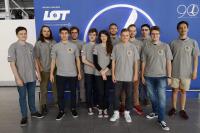Astronautics Student Research Group ready to conquer 2019 University Rover Challenge

The team representing SKA at this year’s University Rover Challenge; photo: SKA
Beside the Robotics Student Research Group, this year’s University Rover Challenge finals will see the representatives of the Astronautic Student Research Group (“SKA”). We sat with Michał Hałoń, the Autonomy Team Leader, to ask him about the preparations for the event at SKA and what can be expected of their rover, Sirius.
You will be competing at this year’s URC with Sirius. Which of its elements would you consider unique? What can make your rover stand out from the competition?
Based on the videos submitted by other teams for the System Acceptance Review, we can say that Sirius is distinguished by its Science module, i.e. its design, the soil sample reagent dispensing solution and the method of sample analysis. Our onboard devices are capable of examining the geological structure and the presence of extant life as well as the potential for life in the future. We are also able to record images of radiation on the surface with a camera developed under an individual grant “The Best of the Best! 2.0”. Interestingly, one of the devices, the optical spectrometer, has been patented by one of our team.
How long has it taken you to prepare for 2019 URC?
The rover design has been developed over the last three years and, since October 2018, our team has been working with this particular competition in mind. About 30 people have been working on this project (including two doctoral students), of which 14 are going to the US for the event. Members of our team come from several Faculties: the Faculty of Power and Aeronautical Engineering; the Faculty of Electronics and Information Technology; the Faculty of Mechatronics and the Faculty of Electrical Engineering.
Tell us about your role on the team.
I am responsible for the rover’s autonomous traversal of the venue area. The robot will have to reach waypoints, or tennis balls, the location of which will be provided as GPS coordinates and do that autonomously, without control from the team members. With each further waypoint the provided coordinates will become more and more vague forcing the rover to locate the waypoints using its tennis ball detection system. The rover may encounter obstacles such as stones, loose sand or high-angled slopes on its way. To complete this task, we have developed algorithms for autonomous traversal or detection of tennis balls from the camera feed.
What are the biggest concerns and hopes of Sirius’s keepers?
First and foremost, we are concerned about the desert conditions: high temperatures that can compromise electronics and the rough terrain. Previously, many teams finished the autonomous traversal task scoring zero to a few points out of 100. Competing against the best teams in the world is definitely a challenge. Universities such as Stanford or Missouri are represented at URC.
We hope to perform well in the task of soil sampling and onboard analysis. Also, we want to reproduce the panel operations we have shown in our SAR video; this is, for instance, opening screws or typing on a keyboard. For our mission to be successful, our rover, which was dispatched in a separate parcel more than a week before our departure must first arrive safe and sound.
Are you going to the competition with a plan to make contacts that would help develop this or other SKA’s projects?
Of course, we are! The Challenge is a meet-up of teams from all over the world. Already at the European Rover Challenge, we met, say, a team from Switzerland who came there with an advanced walking robot. This will be an opportunity for us to see solutions applied by other teams, which often differ from ours. We will ask for the details, share experiences and this will help us improve, make corrections or even build all-new components for our rover for the future installments of the competition.
***
Michał Hałoń is a PhD student at the Warsaw University of Technology Faculty of Electronics and Information Technology. In 2018, he received a master’s degree in Automation and Robotics with an excellent result from the Warsaw University of Technology Faculty of Power and Aeronautical Engineering. He is the winner of the Scientific Award of the President of the Polish Space Agency for the best master’s thesis in Space Engineering. His scientific interests include image processing and biometric applications for mobile devices and machine learning.







